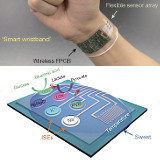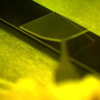Email not displaying correctly? View it in your browser. | |||||||||||
 | |||||||||||
| |||||||||||
 Role of Nanomanufacturing in Wearable Sensor TechnologiesThe recent explosion of wearable consumer products for monitoring physiological information, such as heart rate or skin temperature, provides the promise for personalized medicine wherein an individual’s health status can be continuously evaluated. The evolution of wearable sensor systems will eventually incorporate a host of multivariate sensing technologies capable of analyzing biometric signatures and analytes in sweat enabling the ability to assess disease, physical performance, hydration, and other targeted conditions. Wearable sensor systems will be created by flexible-hybrid electronics manufacturing approaches through which silicon electronics will be integrated with sensors, power and energy harvesting, and wireless communications in wearable form factors. While most commercial product launches have been based on microelectromechanical systems (MEMS) sensors and silicon integrated circuits (ICs), future products will incorporate more components formed by printing. As such, nanomaterials and nanomanufacturing approaches will have a broader impact on wearable sensor and health monitoring applications. Numerous research papers have reported the use of nanomaterials having a range of specific functionalities integrated in discrete sensor configuration. Example materials include carbon nanotubes, metallic and metal-oxide nanoparticles, which provide high surface area, and can be printed by various techniques to form thin films or compositions. Recently Gao et. al. reported on a multi-sensor array fabricated on plastic capable of measuring several analytes from sweat. This approach utilized large-scale thin film electrodes having functional chemical coatings to selectively measure specific reactions or ions present in the sweat, and included integrated circuits to condition and process the sensor data, demonstrating an increased level of data to interpret. Similar platforms are under development elsewhere, and an increase in the capability and performance of wearable sensor technologies is anticipated. One key challenge to commercialization is scalable manufacturing approaches to drive costs down and improve performance. Emerging nanomanufacturing methods in print and additive processes will have a significant impact, establishing approaches for integration of heterogeneous materials and devices providing the make-up for emerging wearable sensing platforms. |
|||||||||||
 Tailoring Electrocatalytic Properties by Nanoengineered Bulk Metal Glass SurfacesBulk metallic glasses (BMGs) are amorphous metallic alloys produced by melting and thermal quenching which exhibit desirable properties such as high strength and good formability (at reduced temperatures versus pure metals). As a result, these materials are ideal for patterning and controlling the morphology, with example applications in nanoimprint lithography molds, plastic-replacement components, and field emission devices.  New NSF and NBC Learn video series shows off big discoveries from tiny particlesWhy are things so small, so significant? A new video series created by the National Science Foundation (NSF) and NBC Learn, the educational arm of NBCUniversal News, sheds light on this question.  Nanotechnology manufacturing could benefit from novel nanosheet growth techniqueAfter six years of painstaking effort, a group of University of Wisconsin-Madison materials scientists believe their breakthrough in growing tiny sheets of zinc oxide could have huge implications for the future of nanomaterial manufacturing—and in turn, on a host of electronic and biomedical devices. |
January 2016
|
||||||||||
| |||||||||||














